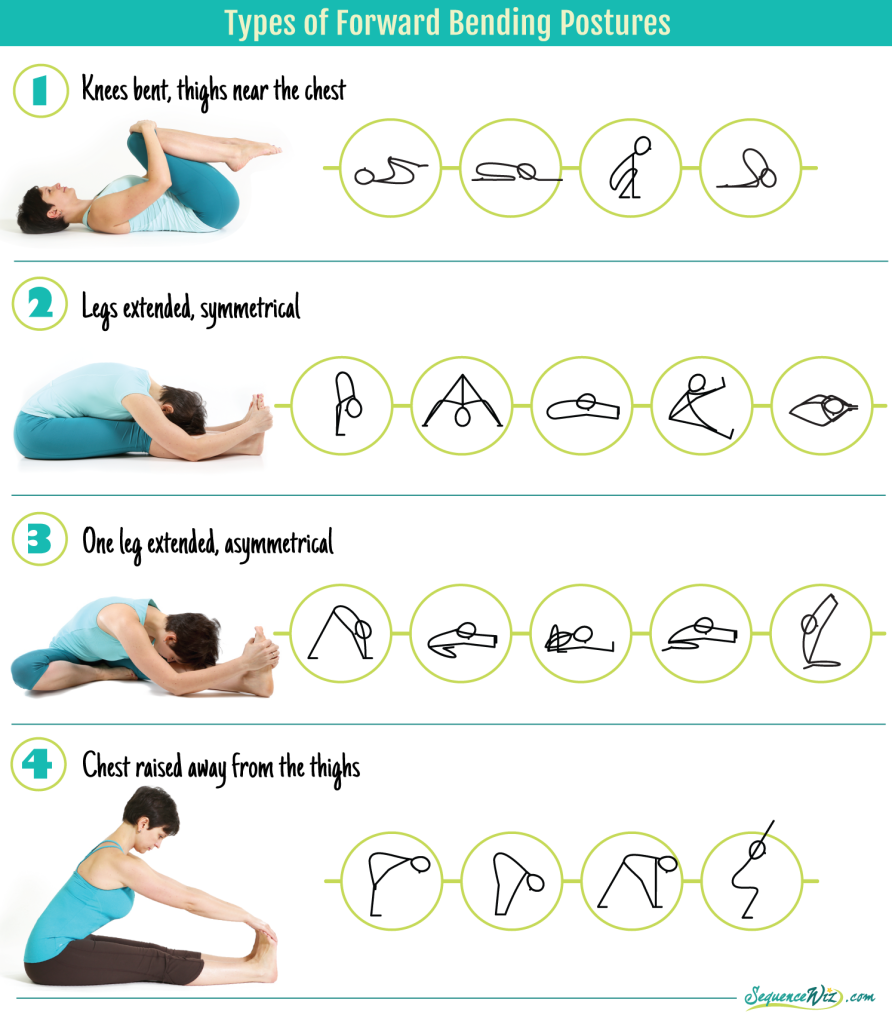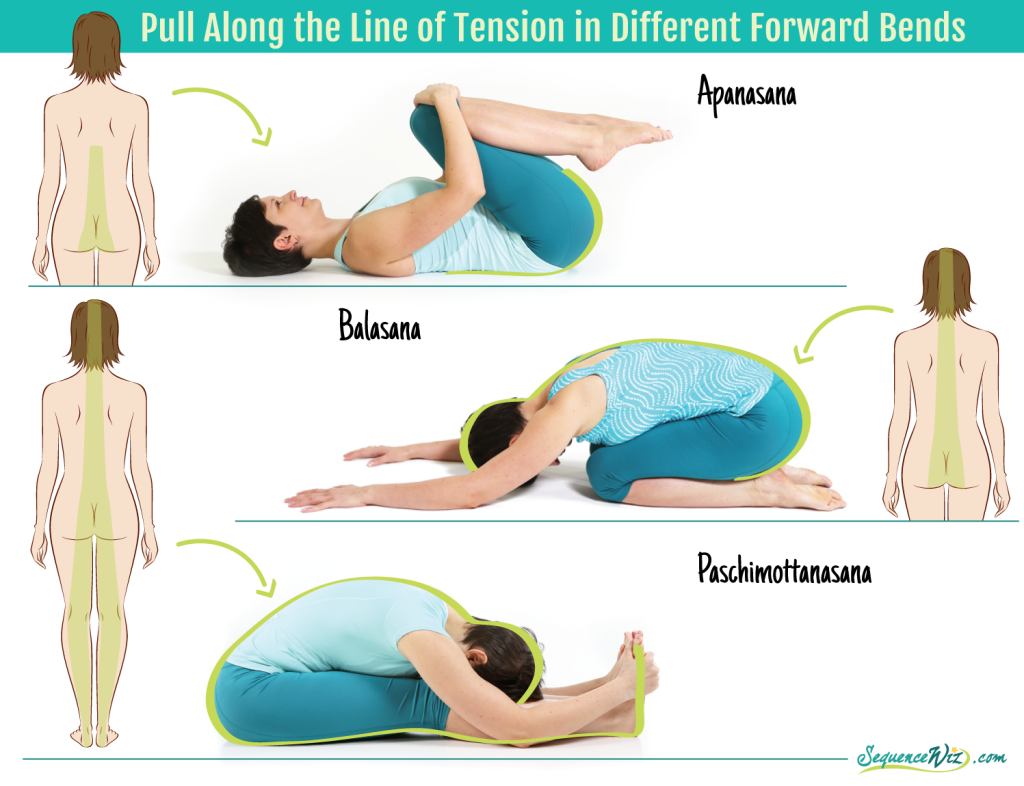Why do we do forward bends in yoga?

I heard an interesting theory that older women who have osteoporosis in their spine shouldn’t practice forward bends because of the risk of additional fractures. This theory is based on a study of three patients who experienced new pain and fractures after doing “yoga flexion exercises.” I find it curious since our everyday lives are full of flexion. Try putting on pants or socks without flexing your spine. Should women avoid those activities as well?
After careful reading, it becomes clear that when the study talks about “strenuous yoga flexion exercises,” it doesn’t mean just forward bends. It specifically lists poses like Paschimottanasana (which is a forward bend), but also the Bridge pose and Shoulderstand, both of which put the cervical spine in the extreme flexed position. The study isn’t really talking about forward bends but more about extreme spinal flexion. Why would we ever recommend that to somebody with osteoporosis in the spine?! In addition, another study shows that the negative effects of “strenuous yoga flexion exercises” are neutralized by doing extension poses. Isn’t that how we usually structure our yoga practices?
There are many forward bends that are very useful for the body; and even deep forward bends like Uttanasana and Paschimottanasana done with proper technique and adapted to the needs of the student, should NOT stress the spine. Today we begin a conversation about the kinds of forward bends that are out there, what they are for and how we can minimize the risk while practicing them.
To bend forward means to flex the spine, which happens every time you move your chest toward your thighs (and visa versa). If we arrange forward bends according to intensity, it would look like this:
The main quality that all forward bends share is that they create a stretch in the posterior (back) structures of the body. One thing that we need to remember is that all of those structures are interlinked via fascia. Thomas Myers, in his book Anatomy Trains, adopted the term myofascial meridians to describe those lines of pull that run through a sheet of fascia and connect and envelop several muscles. He calls this particular line of tension the Superficial back line (SBL).
The SBL connects and protects the entire posterior surface of the body. It has an important postural function – it supports the body in the full upright position, which means that it is loaded all day, every day. It also creates spinal extension (back bending). If the muscles along this line are underdeveloped, the body will tend to collapse forward; if they become overdeveloped, the body will have a tendency to lean back. Forward bends help relieve tension all along the SBL and stretch it in parts or as a whole.
We use forward bends to work the entire SBL: to both stretch and strengthen (depending on the pose) the muscles along the spine, as well as the muscles of the shoulder and pelvic girdles, and legs. In addition, forward bends strengthen the abdominal muscles (if you engage them when you practice), and gently compress abdominal organs, increasing circulation to the area.
We do have our priorities when it comes to stretching the structures of the back. The lower back is ALWAYS the most important part. This is the area that usually takes on the majority of the load, and it is the most important in terms of supporting the spine and creating a healthy relationship between the spine and the pelvis.
In addition to stretching the lower back, you might choose to emphasize the upper back, hamstrings or calves; some poses will be more suited for that than others.

Let’s take a look at different types of forward bends and what we can expect to get out of them.

Group 1 poses offer safe and effective stretching of the lower back.
Group 2 poses create a deeper stretch for the back (especially when the stretch is facilitated by the hands), and also stretch the upper back, neck, and hamstrings. Keeping the legs apart will introduce a stretch in the inner thighs. Flexing the ankles will stretch the calves as well.
Group 3 poses isolate and emphasize the stretch on one side of the body, which is very useful when working with structural asymmetries.
Group 4 poses strengthen the upper and lower back. The strengthening effect will intensify if one or both arms are raised.
Thinking of yoga poses in terms of their usefulness fundamentally changes your approach to a yoga practice. Then, poses become tools that you can carefully select and arrange for either therapeutic or developmental purposes.

How do you know what each yoga pose is meant to accomplish? When you are clear about the purpose of each pose, you will know how to choose an appropriate pose, how to teach it, and how to adapt it to a specific student.












Great job. Excellent explanation of the use and variety of forward bending.
Thank you Georgeanna!
Olga, thanks for bringing up this important issue–osteoporosis and a safe yoga practice. I would like to weigh in. The issue in forward bending is about preventing spinal wedge compressions. Wedge compressions depend on two factors: the weakness of the spinal vertebrae (DEXA scan numbers) and the weight of the upper body exerting downward compression on those vulnerable vertebrae. Most experts warn against asking the spine to bear weight in a forward bend. So the issue become how to achieve the benefits of forward bending without bringing on the risk. Your illustrations show several excellent options. For the sake of safety, I would like to add that preventing spinal rounding through the strength of back muscles and using the arms for support offers two avenues for increased safety for those who are vulnerable to compression fractures.
I have been teaching an osteoporosis intervention yoga practice for more than 15 years and will next offer this material in a workshop next held in Virginia @ Yogaville in late July.
This is fantastic Kay, thank you for your input! We will talk about safe forward bending technique next time and I will use some of your points. Do you want to give me a bit more information about your workshop so that I could mention it?
Great post concerning forward bends and their relative safety. I think one issue to consider is the effect that stretching the back has on the ligament structures needed for upright alignment. Pulling on our back line by bending forward in some ways creates the exact problem we seek to solve. Since there is not a lot of sensory innervation in the ligament structures too, we must be careful when muscling forward to grab our toes with knees straight. Most people I work with have tense muscles in the SBL ( which I prefer to call the extensor line) These muscles are tense but long or locked long.. They do not need to be stretched at all, they need to be shortened. The stretch reflex will give about 20 minutes of pain relief by doing these forward bends with spine flexion but the pain will return.
Another thing to consider is the loosening of the sacral platform that occurs by bending forward. We do not need to pull on our parts, we need to balance tension by returning to the deep line or as I call it the breathing line. See my work at http://www.yogalign.com
Michaelle,
I am a novice yoga teacher (3+ years experience) @ Lila Yoga (www.lilayoga.com) and I have plenty to learn. Could you expand upon the meaning of “tense but long or locked long” muscles? How do you identify someone with this condition? And, how do you recommend resolving this imbalance through yoga?
Thank you.
Stacy
Would like to know more about stretching exercises of lower back osteoporosis
Olga, your postings are simply brilliant and oh so very useful. Thank-you for so generously sharing your knowledge and experience. I am sharing them on.
Great article to help me prepare for teaching my beginning yoga series! Do you have a similar article on backbending?
Hi Beth, we sure do! All the articles on the directional movements of the spine are summarized here under How to do yoga poses: http://sequencewiz.org/2015/12/30/best-of-2015/ Hope this helps!
I’m so glad I came across your articles! I’m a 60 year old beginner/intermediate and found this fascinating and very useful! I’ve been wondering about this very thing – what the poses are meant to do and how they are helping me as well as the correct form. Thank you for the great information!
Olga, you have an amazing website! Thank you very much!
I have two question though…
Which forward bends would strength the SBL? As far as i see it mostly stretches it. Apart from group 4, specially on standing versions with the use of props (or fingertips) to keep working on it while maintaining the trunk away. I guess you can use the same concept to group 2 as well if you do focus on maintaining some angle while folding forward….
Last question is about engaging core muscles while folding forward. Why would you do that in those poses?
Thank you 🙂
Good information, but I think we have to keep in mind that there are varying degrees of osteoporosis. My mother is 84 and has severe osteoporosis. She stood up last year and both ankles broke. Her doctor has specifically told her not to bend over (forward fold), or she risks fractures in her spine. I am very interested in teaching for an older population, but I will be very cautious about recommending forward folds to those with osteoporosis.
thank you so much for this very insightful article
Olga. May Lord bless you. It is one of the greatest website I have ever seen. Greeeeeeeeeeeat job. Nice diagrams and Very informative explanation. I like it.